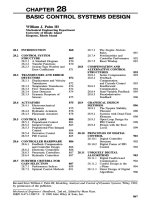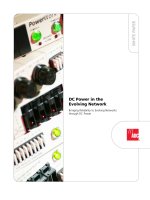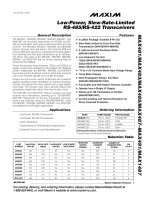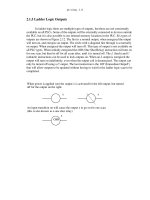Tài liệu ELECTRIC POWER SYSTEMS A CONCEPTUAL INTRODUCTION pptx
Bạn đang xem bản rút gọn của tài liệu. Xem và tải ngay bản đầy đủ của tài liệu tại đây (10.85 MB, 329 trang )
ELECTRIC POWER
SYSTEMS
A CONCEPTUAL INTRODUCTION
Alexandra von Meier
A JOHN WILEY & SONS, INC., PUBLICATION
ELECTRIC POWER
SYSTEMS
ELECTRIC POWER
SYSTEMS
A CONCEPTUAL INTRODUCTION
Alexandra von Meier
A JOHN WILEY & SONS, INC., PUBLICATION
Copyright # 2006 by John Wiley & Sons, Inc. All rights reserved
Published by John Wiley & Sons, Inc., Hoboken, New Jersey
Published simultaneously in Canada
No part of this publication may be reproduced, stored in a retrieval system, or transmitted in any form
or by any means, electronic, mechanical, photocopying, recording, scanning, or otherwise, except as
permitted under Section 107 or 108 of the 1976 United States Copyright Act, without either the prior
written permission of the Publisher, or authorization through payment of the appropriate per-copy fee
to the Copyright Clearance Center, Inc., 222 Rosewood Drive, Danvers, MA 01923, (978) 750-8400,
fax(978)750-4470,orontheWebatwww.copyright.com.RequeststothePublisherforpermission
should be addressed to the Permissions Department, John Wiley & Sons, Inc., 111 River Street, Hoboken,
NJ 07030, (201) 748-6011, fax (201) 748-6008, or online at />Limit of Liability/Disclaimer of Warranty: While the publisher and author have used their best efforts
in preparing this book, they make no representations or warranties with respect to the accuracy or com-
pleteness of the contents of this book and specifically disclaim any implied warranties of merchantability
or fitness for a particular purpose. No warranty may be created or extended by sales representatives or
written sales materials. The advice and strategies contained herein may not be suitable for your situation.
You should consult with a professional where appropriate. Neither the publisher nor author shall be liable
for any loss of profit or any other commercial damages, including but not limited to special, incidental,
consequential, or other damages.
For general information on our other products and services or for technical support, please contact our
Customer Care Department within the United States at (800) 762-2974, outside the United States at
(317) 572-3993 or fax (317) 572-4002.
Wiley also publishes its books in a variety of electronic formats. Some content that appears in print may
not be available in electronic formats. For more information about Wiley products, visit our Web site at
www.wiley.com.
Library of Congress Cataloging-in-Publication Data:
Meier, Alexandra von.
Electric power systems: a conceptual introduction/by Alexandra von Meier.
p. cm.
“A Wiley-Interscience publication.”
Includes bibliographical references and index.
ISBN-13: 978-0-471-17859-0
ISBN-10: 0-471-17859-4
1. Electric power systems. I. Title
TK1005.M37 2006
621.31–dc22 2005056773
Printed in the United States of America
10987654321
To my late grandfather
Karl Wilhelm Clauberg
who introduced me to
The Joy of Explaining Things
&
CONTENTS
Preface xiii
1. The Physics of Electricity 1
1.1 Basic Quantities 1
1.1.1 Introduction 1
1.1.2 Charge 2
1.1.3 Potential or Voltage 3
1.1.4 Ground 5
1.1.5 Conductivity 5
1.1.6 Current 6
1.2 Ohm’s law 8
1.2.1 Resistance 9
1.2.2 Conductance 10
1.2.3 Insulation 11
1.3 Circuit Fundamentals 11
1.3.1 Static Charge 11
1.3.2 Electric Circuits 12
1.3.3 Voltage Drop 13
1.3.4 Electric Shock 13
1.4 Resistive Heating 14
1.4.1 Calculating Resistive Heating 15
1.4.2 Transmission Voltage and Resistive Losses 17
1.5 Electric and Magnetic Fields 18
1.5.1 The Field as a Concept 18
1.5.2 Electric Fields 19
1.5.3 Magnetic Fields 21
1.5.4 Electromagnetic Induction 24
1.5.5 Electromagnetic Fields and Health Effects 25
1.5.6 Electromagnetic Radiation 26
2. Basic Circuit Analysis 30
2.1 Modeling Circuits 30
vii
2.2 Series and Parallel Circuits 31
2.2.1 Resistance in Series 32
2.2.2 Resistance in Parallel 33
2.2.3 Network Reduction 35
2.2.4 Practical Aspects 36
2.3 Kirchhoff’s Laws 37
2.3.1 Kirchhoff’s Voltage Law 38
2.3.2 Kirchhoff’s Current Law 39
2.3.3 Application to Simple Circuits 40
2.3.4 The Superposition Principle 41
2.4 Magnetic Circuits 44
3. AC Power 49
3.1 Alternating Current and Voltage 49
3.1.1 Historical Notes 49
3.1.2 Mathematical Description 50
3.1.3 The rms Value 53
3.2 Reactance 55
3.2.1 Inductance 55
3.2.2 Capacitance 58
3.2.3 Impedance 64
3.2.4 Admittance 64
3.3 Power 66
3.3.1 Definition of Electric Power 66
3.3.2 Complex Power 68
3.3.3 The Significance of Reactive Power 73
3.4 Phasor Notation 75
3.4.1 Phasors as Graphics 75
3.4.2 Phasors as Exponentials 78
3.4.3 Operations with Phasors 80
4. Generators 85
4.1 The Simple Generator 86
4.2 The Synchronous Generator 92
4.2.1 Basic Components and Functioning 92
4.2.2 Other Design Aspects 97
4.3 Operational Control of Synchronous Generators 100
4.3.1 Single Generator: Real Power 100
4.3.2 Single Generator: Reactive Power 101
4.3.3 Multiple Generators: Real Power 107
4.3.4 Multiple Generators: Reactive Power 112
viii
CONTENTS
4.4 Operating Limits 115
4.5 The Induction Generator 118
4.5.1 General Characteristics 118
4.5.2 Electromagnetic Characteristics 120
4.6 Inverters 123
5. Loads 127
5.1 Resistive Loads 128
5.2 Motors 131
5.3 Electronic Devices 134
5.4 Load from the System Perspective 136
5.4.1 Coincident and Noncoincident Demand 137
5.4.2 Load Profiles and Load Duration Curve 138
5.5 Single- and Multiphase Connections 140
6. Transmission and Distribution 144
6.1 System Structure 144
6.1.1 Historical Notes 144
6.1.2 Structural Features 147
6.1.3 Sample Diagram 149
6.1.4 Topology 150
6.1.5 Loop Flow 153
6.1.6 Stations and Substations 156
6.1.7 Reconfiguring the System 158
6.2 Three-Phase Transmission 159
6.2.1 Rationale for Three Phases 160
6.2.2 Balancing Loads 163
6.2.3 Delta and Wye Connections 164
6.2.4 Per-Phase Analysis 166
6.2.5 Three-Phase Power 166
6.2.6 D.C. Transmission 167
6.3 Transformers 168
6.3.1 General Properties 168
6.3.2 Transformer Heating 170
6.3.3 Delta and Wye Transformers 172
6.4 Characteristics of Power Lines 175
6.4.1 Conductors 175
6.4.2 Towers, Insulators, and Other Components 179
6.5 Loading 182
6.5.1 Thermal Limits 182
6.5.2 Stability Limit 183
CONTENTS ix
6.6 Voltage Control 184
6.7 Protection 188
6.7.1 Basics of Protection and Protective Devices 188
6.7.2 Protection Coordination 192
7. Power Flow Analysis 195
7.1 Introduction 195
7.2 The Power Flow Problem 197
7.2.1 Network Representation 197
7.2.2 Choice of Variables 198
7.2.3 Types of Buses 201
7.2.4 Variables for Balancing Real Power 201
7.2.5 Variables for Balancing Reactive Power 202
7.2.6 The Slack Bus 204
7.2.7 Summary of Variables 205
7.3 Example with Interpretation of Results 206
7.3.1 Six-Bus Example 206
7.3.2 Tweaking the Case 210
7.3.3 Conceptualizing Power Flow 211
7.4 Power Flow Equations and Solution Methods 214
7.4.1 Derivation of Power Flow Equations 214
7.4.2 Solution Methods 217
7.4.3 Decoupled Power Flow 224
7.5 Applications and Optimal Power Flow 226
8. System Performance 229
8.1 Reliability 229
8.1.1 Measures of Reliability 229
8.1.2 Valuation of Reliability 231
8.2 Security 233
8.3 Stability 234
8.3.1 The Concept of Stability 234
8.3.2 Steady-State Stability 236
8.3.3 Dynamic Stability 240
8.3.4 Voltage Stability 249
8.4 Power Quality 250
8.4.1 Voltage 251
8.4.2 Frequency 253
8.4.3 Waveform 255
x
CONTENTS
9. System Operation, Management, and New Technology 259
9.1 Operation and Control on Different Time Scales 260
9.1.1 The Scale of a Cycle 261
9.1.2 The Scale of Real-Time Operation 262
9.1.3 The Scale of Scheduling 264
9.1.4 The Planning Scale 267
9.2 New Technology 268
9.2.1 Storage 268
9.2.2 Distributed Generation 271
9.2.3 Automation 278
9.2.4 FACTS 280
9.3 Human Factors 281
9.3.1 Operators and Engineers 281
9.3.2 Cognitive Representations of Power Systems 282
9.3.3 Operational Criteria 285
9.3.4 Implications for Technological Innovation 291
9.4 Implications for Restructuring 292
Appendix: Symbols, Units, Abbreviations, and Acronyms 298
Index 302
CONTENTS xi
&
PREFACE
This book is intended to bridge the gap between formal engineering texts and more
popularly accessible descriptions of electric power technology. I discovered this
gap as a graduate student struggling to understand power systems—especially trans-
mission and distribution systems—which had always fascinated me but which now
invited serious study in the context of research on implementing solar energy.
Although I had studied physics as an undergraduate, I found the subject of power
systems difficult and intimidating.
The available literature seemed to fall into two categories: easy-to-read, qu alitat-
ive descriptions of the electric gri d for the layperson, on the one hand, and highly
technical books and papers, on the other hand, written for professionals and
electrical engineering majors. The second category had the information I needed,
but was guarded by a layer of impenetrable phasor diagrams and other symbolism
that obviously required a special sort of initiation.
I was extremely fortunate to have access to some of the most highly respected
scholars in the field at the University of California, Berkeley, who were also gener-
ous, patient, and gifted teachers. Thus I survived Leon Chua’s formidable course on
circuit analysis, followed by two semesters of power engineering with Felix Wu.
This curriculum hardly made me an expert, but it did enable me to decipher the
language of the academic and professional literature and identify the issues relevant
to my work.
I enjoyed another marvelous learning opportunity through a research project
beginning in 1989 at several large nucl ear and fossil-fueled steam generation
plants, where our team interviewed the staff as part of a study of “High-Reliability
Organizations.” My own subsequent research on power distribution took me into the
field with five U.S. utilities and one in Germany. Aside from the many intriguing
things we learned about the operating culture in these settings, I discovered how
clearly the power plant staff could often explain technical concepts about their
working systems. Their language was characteristically plain and direct, and was
always guided by practical considerations, such as what this dial tells you, or
what happens when you push that button.
In hindsight, the defining moment for inspiring this book occurred in the Pittsburg
control room when I revealed my ignorance about reactive power (just after having
boasted about my physics degree, to the operators’ benign amusement). They gener-
ously supplied me with a copy of the plant operating manual, which turned out to
contain the single most lucid and comprehensible explanation of electri c generators,
xiii
including reactive power, I had seen. That manual proved to me that it is possible to
write about electric power systems in a way that is accessible to audiences who have
not undergone the initiation rites of electrical engineering, but who nevertheless
want to get the real story. This experience suggested there might be other people
much like myself—outside the power industry, but vitally concerned with it—
who could benefit from such a practical approach.
After finishing my dissertation in 1995, I decided to give it a try: My goal was to
write the book that I would have liked to read as a student six or seven years earlier.
Considering that it has taken almost a decade to achieve, this turned out to be a much
more ambitious undertaking than I imagined at the outset. A guiding principle
throughout my writing process was to assume a minimum of prior knowledge
on the part of the readers while trying to relate as much as possible to their direct
experience, thus building a conceptual and intuitive understanding from the
ground up. I hope the book will serve as a useful reference, and perhaps even as a
source of further inspiration for others to study the rich and complex subject of
electric power.
I envision two main audiences for this book. The first consists of students and
researchers who are learning about electric circuits and power system engineering
in an academic setting, and who feel that their understanding would be enhanced
by a qualitative, conceptual emphasis to com plement the quantitative methods
stressed in technical courses. This audience might include students of diverse back-
grounds or differing levels of preparation, perhaps transferring into an engineering
program from other disciplines. Such students often need to solidify their
understanding of basic information presumed to be second nature for advanced
undergraduates in technical fields. As a supplement to standard engineering texts,
this volume aims to provide a clear and accessible review of units, definitions,
and fundamental physical principles; to explain in words some of the ideas conven-
tionally shown by equations; to contextualize information, showing connections
among different topics and pointing out their relevance; and to offer a glimpse
into the prac tical world of the electric power industry.
The second major audience consists of professionals working in and around the
power industr y whose educational background may not be in electrical engineering,
but who wish to become more familiar with the technical details and the theoretical
underpinnings of the system they deal with. This group might include analysts
and administrators and managers coming from the fields of business, economics,
law, or public policy, as well as individuals with technical or multidisciplinary
training in areas other than power engineering. In view of the scope and importance
of contemporary policy decisions about electricity supply and delivery, both in the
United States and abroad—from the sitin g of power generation and transmission
facilities to market regulation and restructuring—a real need appears for a coherent,
general education on the subject of power systems. My hope is that this volume can
make a meaningful contribution.
xiv PREFACE
&
ACKNOWLEDGMENTS
Many individuals and organizations have made the writing of this text possible. I am
deeply grateful to my teachers for their mentorship, inspiration, and clarity, most
especially Gene Rochlin, Felix Wu, and Oscar Ichazo. I am also indebted to the
many professionals who took the time to show me around power systems in
the field and teach me about their work. The project was supported directly and
indirectly by a University of California President’s Postdoct oral Fellowship,
the University of California Energy Institute (UCEI), the California Energy
Commission’s Public Interest Energy Research (PIER) program, and the California
Institute for Energy Efficiency (CIEE). I especially thank Carl Blumstein, Severin
Borenstein, Ron Hofmann, Laurie ten Hope, and Gaymond Yee for their encourage-
ment at various stages in the process of writing this book.
I also thank all my colleagues who graciously read, discussed, and helped
improve portions of the draft manuscript. They include Raquel Blanco, Alex
Farrell, Hannah Friedman, John Galloway, Chris Greacen, Sean Greenwalt,
Dianne Hawk, Nicole Hopper, Merrill Jones, Chris Marnay, Andrew McAllister,
Alex McEachern, Steve Shoptaugh, Kurt von Meier, and Jim Williams. My
gratitude also extends to all others who participated in the development of the
text—particularly my students who never cease to ask insightful and challenging
questions—and to my friends and family who offered encouragement and
support. Darcy McCor mick, Thomas Harris, and Steve Shoptaugh helped prepare
illustrations, Cary Berkley organ ized the manuscript, and Trumbull Rogers
improved it by careful editing. Of course, I am solely responsible for any errors.
As an endeavor that has not, to my knowledge, been attempted before, this text
is necessarily a work in progress. Suggestions from readers for improving its
accuracy and clarity will be warmly welcomed.
A
LEXANDRA VON MEIER
Sebastopol, California
August 2005
xv
&
CHAPTER 1
The Physics of Electricity
1.1 BASIC QUANTITIES
1.1.1 Introduction
This chapter describes the quantities that are essential to our understanding of elec-
tricity: char ge, voltage, current, resistance, and electric and magnetic fields. Most
students of science and engineering find it very hard to gain an intuitive appreciation
of these quantities, since they are not part of the way we normally see and make
sense of the world around us. Electrical phenomena have a certain mystique that
derives from the difficulty of associating them with our direct experience, but also
from the know ledge that they embody a potent, fundamental force of nature.
Electric charge is one of the basic dimensions of physical measurement, along
with mass, distance, time and temperature. All other units in physics can be
expressed as some combination of these five terms. Unlike the other four,
however, charge is more remote from our sensory perception. While we can
easily visualize the size of an object, imagine its weight, or anticipate the duration
of a process, it is difficult to conceive of “charge” as a tangible phenomenon.
To be sure, electrical processes are vital to our bodies, from cell metabolism to
nervous impulses, but we do not usually conceptualize these in terms of electrical
quantities or forces. Our most direct and obvious experience of electricity is to
receive an electric shock. Here the presence of charge sends such a strong wave
of nervous impulses through our body that it produces a distinct and unique sen-
sation. Other firsthand encounters with electricity include hair that defiantly
stands on end, a zap from a door knob, and static cling in the laundry. Yet these
experiences hardly translate into the context of electric power, where we can
witness the effects of electricity, such as a glowing light bulb or a rotating motor,
while the essential happenings take place silently and concealed within pieces of
metal. For the most part, then, electricity remains an abstraction to us, and we
rely on numerical and geometric representations—aided by liberal analogies from
other areas of the physical world—to form concepts and develop an intuition
about it.
1
Electric Power Systems: A Conceptual Introduction, by Alexandra von Meier
Copyright # 2006 John Wiley & Sons, Inc.
1.1.2 Charge
It was a major scientific accomplishment to integrate an understanding of electricity
with fundamental concepts about the microscopic nature of matter. Observations of
static electricity like those mentioned earlier were elegantly explained by Benjamin
Franklin in the late 1700s as follows: There exist in nature two types of a property
called charge, arbitrarily labeled “positive” and “negative.” Opposite charges attract
each other, while like charges repel. When certain materials rub together, one type of
charge can be transferred by friction and “charge up” objects that subsequently repel
objects of the same kind (hair), or attract objects of a different kind (polyester and
cotton, for instance).
Through a host of ingenious experiments,
1
scientists arrived at a model of the
atom as being composed o f smaller individual particles with opposite charges,
held together by their electrical attraction. Specifically, the nucleus of an atom,
which constitutes the vast majority of its mass, contains protons with a positive
charge, and is enshrouded by electrons with a negat ive charge. The nucleus also con-
tains neutrons, which resemble protons, except they have no charge. The electric
attraction between protons and electrons just balances the electrons’ natural ten-
dency to escape, which results from both their rapid movement, or kinetic energy,
and their mutual electric repulsion. (The repulsion among protons in the nucleus
is overcome by another type of force called the strong nuclear interaction, which
only acts over very short distances.)
This model explains both why most materials exhibit no obvious electrical prop-
erties, and how they can become “charged” under certain circumstances: The oppo-
site charges carried by electrons and protons are equivalent in magnitude, and when
electrons and protons are present in equal numbers (as they are in a normal atom),
these charges “cancel” each other in terms of their effect on their envi ronment. Thus,
from the outside, the entire atom appears as if it had no charge whatsoever; it is
electrically neutral.
Yet indivi dual electrons can sometimes escape from their atoms and travel else-
where. Friction, for instance, can cause electrons to be transferred from one material
into another. As a result, the material with excess electrons becomes negatively
charged, and the material with a deficit of electrons becomes positively charged
(since the positive charge of its protons is no longer compensated). The ability of
electrons to travel also explains the phenomenon of electric current, as we will
see shortly.
Some atoms or groups of atoms (molecules) naturally occur with a net charge
because they contain an imbalanced number of protons and electrons; they are
called ions. The propensity of an atom or molecule to become an ion—namely, to
release electrons or accept additional ones—results from peculiarities in the geo-
metric pattern by which electrons occupy the space around the nuclei. Even electri-
cally neutral molecules can have a local appearance of charge that results from
1
Almost any introductory physics text will provide examples. For an explanation of the basic concepts of
electricity, I recommend Paul Hewitt, Conceptual Physics, Tenth Edition (Menlo Park, CA: Addison
Wesley, 2006).
2 THE PHYSICS OF ELECTRICITY
imbalances in the spatial distribution of electrons—that is, electrons favoring one
side over the other side of the molecule. These electrical phenomena within mol-
ecules determine most of the physical and chemical properties of all the substances
we know.
2
While on the microscopic level, one deals with fundamental units of charge
(that of a single electron or proton), the practical unit of charge in the context of
electric power is the coulomb (C). One coulomb corresponds to the charge of
6.25 Â 10
18
protons. Stated the other way around, one proton has a charge
of 1.6 Â 10
219
C. One electron has a negative charge of the same magnitude,
21.6 Â 10
219
C. In equations, charge is conventionally denoted by the symbol
Q or q.
1.1.3 Potential or Voltage
Because like charges repel and opposite charges attract, charge has a natural ten-
dency to “spread out.” A local accumulation or deficit of electrons causes a
certain “discomfort” or “tension”:
3
unless physically restricted, these charges will
tend to move in such a way as to relieve the local imbalance. In rigorous physical
terms, the discomfort level is expressed as a level of energy. This energy (strictly,
electrical potential energy), said to be “held” or “possessed” by a charge, is analo-
gous to the mechanical potential energy possessed by a massive object when it is
elevated above the ground: we might say that, by virtue of its height, the object
has an inherent potential to fall down. A state of lower energy—closer to the
ground, or farther away from like charges—represents a more “comfortable”
state, with a smaller potential fall.
The potential energy held by an object or charge in a particular location can be
specified in two ways that are physically equivalent: first, it is the work
4
that
would be required in order to move the object or charge to that location. For
example, it takes work to lift an object; it also takes work to bring an electron
near an accumulation of more electrons. Alternatively, the potential energy is the
work the object or charge would do in order to move from that location, through
interacting with the objects in its way. For example, a weight suspended by a
rubber band will stretch the rubbe r band in order to move downward with the pull
of gravity (from higher to lower gravitational potential). A charge moving toward
a more comfortable location might do work by producing heat in the wire
through which it flows.
2
For example, water owes its amazing liquidity and density at room temperature to the electrical attraction
among its neutral molecules that results from each molecule being polarized: casually speaking, the elec-
trons prefer to hang out near the oxygen atom as opposed to the hydrogen atoms of H
2
O; a chemist would
say that oxygen has a greater electronegativity than hydrogen. The resulting attraction between these
polarized ends of molecules is called a hydrogen bond, which is essential to all aspects of our physical life.
3
The term tension is actually synonymous with voltage or potential, mainly in British usage.
4
In physics, work is equivalent to and measured in the same units as energy, with the implied sense of
exerting a force to “push” or “pull” something over some distance (Work ¼ Force  Distance).
1.1 BASIC QUANTITIES 3
This notion of work is crucial because, as we will see later, it represents the
physical basis of transferring and utilizing electrical energy. In order to make
this “work” a usef ul and unambiguous measure, some proper definitions are necess-
ary. The first is to explicitly distinguish the contributions of charge and potential to
the total amount of work or energy transferred. Clearly, the amount of work in
either direction (higher or lower potential) depends on the amount of mass or
charge involved. For example, a heavy weight would stretch a rubber band
farther, or even break it. Similarly, a greater charge will do more work in order
to move to a lower potential.
On the other hand, we also wish to characterize the location proper, independent
of the object or charge there. Thus, we establish the rigorous definition of the electric
potential, which is synonymous with voltage (but more formal). The electric poten-
tial is the potential energy possessed by a charge at the location in question, relative
to a reference location, divided by the amo unt of its charge. Casually speaking, we
might say that the potential represents a measure of how comfortable or uncomfor-
table it would be for any charge to reside at that location. A potential or voltage can
be positive or negative. A positive voltage implies that a positive charge would be
repelled, whereas a negative charge would be attracted to the location; a negative
voltage implies the opposite.
Furthermore, we must be careful to specify the “reference” location: namely, the
place where the object or charge was moved from or to. In the mechanical context,
we specify the height above ground level. In electricity, we refer to an electrically
neutral place, real or abstract, with zero or ground potential. Theoretically, one
might imagine a place where no other charges are present to exert any forces; in
practice, ground potential is any place where positive and negative charges are
balanced and their influences cancel. When describing the potential at a single
location, it is implicitly the potential difference between this and the neutral location.
However, potential can also be specified as a difference between two locations of
which neither is neutral, like a difference in height.
Because electric potential or voltage equals energy per charge, the units of
voltage are equivalent to units of energy divided by units of char ge. These units
are volts (V). One volt is equivalent to one joule per coul omb, where the joule is
a standard unit of work or energy.
5
Note how the notion of a difference always remains implicit in the measurement
of volts. A statement like “this wire is at a voltage of 100 volts” means “this wire is
at a voltage of 100 volts relative to ground,” or “the voltage difference between the
wire and the ground is 100 volts.” By contrast, if we say “the battery has a voltage of
1.5 volts,” we mean that “the voltage difference between the two terminals of the
battery is 1.5 volts.” Note that the latter statement does not tell us the potential of
either terminal in relation to ground, which depends on the type of battery and
whether it is connected to other batteries.
5
A joule can be expressed as a watt-second; 1 kilowatt-hour ¼ 3.6 Â 10
6
joules, as there are 3600 seconds
in an hour.
4 THE PHYSICS OF ELECTRICITY
In equations, voltage is conventionally denoted by E, e, V,orv (in a rare and
inelegant instance of using the same letter for both the symbol of the quantity and
its unit of measurement).
1.1.4 Ground
The term ground has a very important and specific meaning in the context of electric
circuits: it is an electrically neutral place, meaning that it has zero voltage or poten-
tial, which moreover has the ability to absorb excesses of either positive or negative
charge and disperse them so as to remain neutral regardless of what might be elec-
trically connected to it. The literal ground outdoors has this ability because the Earth
as a whole acts as a vast reservoir of charge and is electrically neutral, and because
most soils are sufficiently conductive to allow charge to move away from any local
accumulation. The term earth is synonymous with ground, especially in British
usage. A circuit “ground” is constructed simply by creating a pathway for charge
into the earth. In the home, this is often done by attaching a wire to metal water
pipes. In power systems, ground wires, capable of carrying large currents if necess-
ary, are specifically dug into the earth.
1.1.5 Conductivity
To understand conductivity, we must return to the microscopic view of matter. In
most materials, electrons are bound to their atoms or molecules by the attraction
to the protons in the nuclei. We have mentioned how special conditions such as fric-
tion can cause electrons to escape. In certain materials, some number of electrons are
always free to travel. As a result, the material is able to conduct electricity. When a
charge (i.e., an excess or deficit of electrons) is applied to one side of such a conduct-
ing material, the electrons throughout will realign themselves, spreading out by
virtue of their mutual repulsion, and thus conduct the charge to the other side.
For this to happen, an individual electron need not travel very far. We can
imagine each electron moving a little to the side, giving its neighbor a repulsive
“shove,” and this shove propagating through the conducting material like a wave
of falling dominoes.
The most important conducting materials in our context are metals. The micro-
scopic structure of metals is such that some electrons are always free to travel
throughout a fixed lattice of positive ions (the atomic nuclei surrounded by the
remaining, tightly bound electrons).
6
While all metals conduct, their conductivity
varies quantitatively depending on the ease with which electrons can travel, or the
extent to which their movement tends to be hampered by microscopic forces and
collisions inside the material.
6
This property can be understood through the periodic table of the elements, which identifies metals as
being those types of atoms with one or a few electrons dwelling alone in more distant locations from
the nucleus (orbitals), from where they are easily removed (ionized) so as to become free electrons.
1.1 BASIC QUANTITIES 5
Besides metals, there are other types of material that conduct electricity. One is
water, or any other fluid, with dissolved ions (such as salt or minerals). In this case, it
is not electrons but entire charged molecules that travel through the fluid to carry a
current. Only small concentrations of ions are needed to make water conductive;
while pure distilled water does not conduct electricity, normal tap water and rain
water conduct all too well.
7
Some materials, including air, can also become temporarily conductive through
ionization. In the presence of a very strong potential gradient (defined as an electric
field in Section 1.5), or intense heat, some electrons are stripped from their mol-
ecules and become free to travel. A gas in this state is called a plasma. Plasmas
exist inside stars, nuclear fusion reactors, or fluorescent lights. More often,
though, ionization tends to be local and transient: it occurs along a distinct trail,
since ionized molecules incite their neighbors to do the same, and charge flows
along this trail until the potential difference (charge imbalance) is neutralized.
This is precisely what happens in an electric spark across an air gap, an arc
between power lines, or a lightning bolt.
8
In many engineering situations, it is important to predict just when ionization
might occur; namely, how great a potential difference over how short a distance
will cause “arcing.” For air, this varies according to temperature and especially
humidity, as well as the presence of other substances like salt suspended in the
air. Exact figures for the ionizing potential can be found in engineering tables.
For units of conductivity and the relationship to resistance, see Section 1.2.
Finally, some materials can become superconducting , generally at very low
temperatures. Here, electrons undergo a peculiar energetic transition that allows
them to travel with extreme ease, unimpeded by any obstructive forces or collisions.
Thus, electrons in the superconducting state do no work on anything in their path,
and therefore lose no energy. Some ceramic materials attain superconductivity at
a temperature easily sustained by cooling with liquid nitrogen (at minus 3198F).
9
While liquid nitrogen is quite cheap in a research setting, large-scale refrigeration
systems aimed at taking advantage of superconductivity in electric power appli-
cations are generally considered too formidable in cost to be justified by the
savings in electric losses (see Section 1.3). Another conce ivable application of
superconductivity in power systems is superconducting magnetic energy storage
(SMES).
1.1.6 Current
When charge travels through a material, an electric current is said to flow. The
current is quantified in terms of the number of electrons (or equivalent charge, in
7
In fact, conductivity is used as an indicator of water purity. Of course, it says nothing about the kind of
ions present, only the amount.
8
The ionization trail is visible because, as the electrons return to their normal state, the balance of their
energy is released in the form of light.
9
The first such material to be discovered was yttrium-barium-copper oxide, YBa
2
Cu
3
O
7
.
6 THE PHYSICS OF ELECTRICITY









